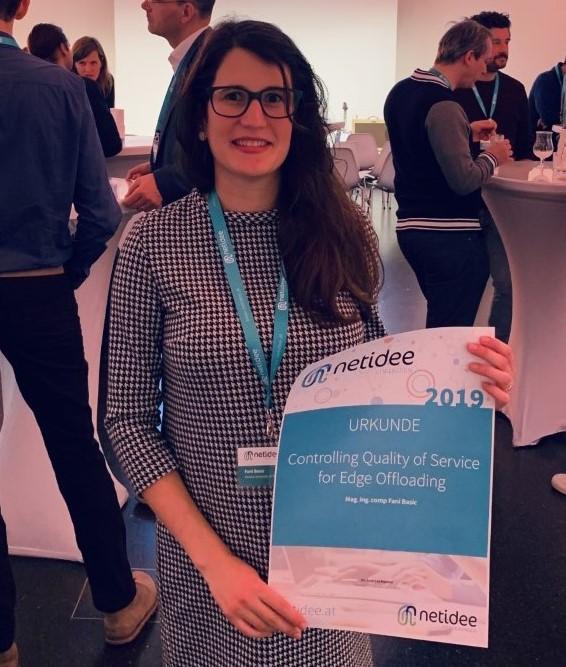
Förderjahr / / ProjektID: / Projekt: State-of-the-Art
The idea of distributing cloud-like virtualized servers at the network edge, providing computing and storage resources in physical proximity to the user equipment has attracted significant attention from both industry and academia in recent years.
The idea is even further developed under the umbrella of concepts also known as Edge computing [1], Fog computing [2], and Mobile Edge Computing (MEC) [3].
Offloading techniques
A comprehensive analysis of the impact and the advantages of exploiting ultra-low latency edge nodes is given by [4] and [5]. Their results show that placing computation close to the source of data can alleviate network congestion problems and bring cost-benefits for bandwidth-hungry applications [5] as well as performance and energy improvement even for highly interactive and compute-intensive applications such as mobile augmented reality or cognitive assistance [4]. An extensive survey on different offloading techniques in the edge context is given by [6], based on three key aspects: i) decision on computation offloading, ii) allocation of computing resources and iii) mobility management.
According to the authors [6], the alpha and the omega of current research regarding the MEC is how to guarantee service continuity in highly dynamic scenarios. This part is lacking in terms of research and is one of the obstacles to the realization of MEC concept.
Seamless mobility
Cloud computing ignores user mobility as computation and data processing can be sent for execution even on a geographically distant data center. For edge offloading it is very important to consider the impact of user mobility. Only a few works consider user behavior and user mobility prediction. However, those works present the promising results in incorporating mobility prediction in content-caching at edge nodes [7] or proactive VM placement and migration [8].
Nowadays, with the development of Vehicular Ad-hoc NETworks (VANET) the possibility of exchanging information with other vehicles and road components, as well as connectivity and seamless mobility – becomes the key aspect [9], [10].
Quality of Service (QoS)
QoS is an important factor for services in this field and can be divided into four aspects according to [11]: connectivity, reliability, capacity, and delay. For monitoring and guaranteeing QoS in the Cloud, there are mature methods available in the literature. However, self-adaptive applications for QoS monitoring developed for edge computing frameworks are at an early stage of research and development as reported by [12]. Therefore, the authors provide a comparison of the widely used cloud monitoring technologies. They highlight several technical problems in applying existing cloud monitoring approaches for edge computing purposes, which could be considered to enhance the performance of such adaptive applications. Moreover, authors provide a discussion on the main challenges in the field of monitoring QoS for edge computing applications.
Although there is a number of studies, Edge computing area is still very far from a generalized solution, capable of providing overall mobility and service continuity, particularly when considering strict QoS requirements [13]. Therefore, our work tries to close this gap.
References:
[1] W. Shi, J. Cao, Q. Zhang, Y. Li, and L. Xu, “Edge computing: Vision and challenges,” IEEE Internet of Things Journal, vol. 3, no. 5, pp. 637-646, 2016.
[2] F. Bonomi, R. Milito, J. Zhu, and S. Addepalli, “Fog computing and its role in the internet of things,” in Proceedings of the first edition of the MCC workshop on Mobile cloud computing. ACM, 2012, pp. 13-16.
[3] T. Taleb, S. Dutta, A. Ksentini, M. Iqbal, and H. Flinck, “Mobile edge computing potential in making cities smarter,” IEEE Communications Magazine, vol. 55, no. 3, 2017.
[4] W. Hu, Y. Gao, K. Ha, J. Wang, B. Amos, Z. Chen, P. Pillai, and M. Satyanarayanan, “Quantifying the impact of edge computing on mobile applications,” in Proceedings of the 7th ACM SIGOPS Asia-Pacific Workshop on Systems. ACM, 2016, p. 5.
[5] A. Mehta, W. Tarneberg, C. Klein, J. Tordsson, M. Kihl, and E. Elmroth, “How beneficial are intermediate layer data centers in mobile edge networks?” in 2016 IEEE 1st International Workshops on Foundations and Applications of Self* Systems (FAS* W). IEEE, 2016, pp. 222-229.
[6] P. Mach and Z. Becvar, “Mobile edge computing: A survey on architecture and computation offloading, ” IEEE Communications Surveys & Tutorials, vol. 19, no. 3, pp. 1628-1656, 2017.
[7] A. S. Gomes, B. Sousa, D. Palma, V. Fonseca, Z. Zhao, E. Monteiro, T. Braun, P. Simoes, and L. Cordeiro, “Edge caching with mobility prediction in virtualized lte mobile networks,” Future Generation Computer Systems, vol. 70, pp. 148-162, 2017.
[8] D. Goncalves, K. Velasquez, M. Curado, L. Bittencourt, and E. Madeira, “Proactive virtual machine migration in fog environments,” in 2018 IEEE Symposium on Computers and Communications (ISCC). IEEE, 2018, pp. 00 742-00 745.
[9] Z. Laaroussi, R. Morabito, and T. Taleb, “Service provisioning in vehicular net-works through edge and cloud: an empirical analysis,” in 2018 IEEE Conference on Standards for Communications and Networking (CSCN). IEEE, 2018, pp. 1–6.5.
[10] V. De Maio, R. B. Uriarte, and I. Brandic, “Energy and profit-aware proof-of-stake offloading in blockchain-based vanets,” in Proceedings of the 12th IEEE/ACM International Conference on Utility and Cloud Computing. ACM, 2019, pp. 177–186.
[11] S. Yi, C. Li, and Q. Li, “A survey of fog computing: concepts, applications and issues,” in Proceedings of the 2015 workshop on mobile big data. ACM, 2015, pp. 37-42.
[12] S. Taherizadeh, A. C. Jones, I. Taylor, Z. Zhao, and V. Stankovski, “Monitoring self-adaptive applications within edge computing frameworks: A state-of-the-art review,” Journal of Systems and Software, vol. 136, pp. 19-38, 2018.
[13] H. Abdah, J. P. Barraca, and R. L. Aguiar, “Qos-aware service continuity in the virtualized edge,” IEEE Access, vol. 7, pp. 51 570–51 588, 2019.


